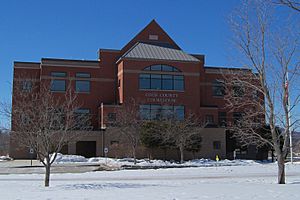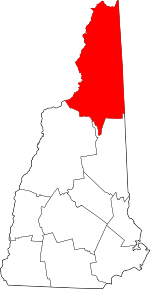Coös County, New Hampshire facts for kids
Quick facts for kids
Coös County
|
|
|---|---|

Coös County Courthouse in Lancaster
|
|

Location within the U.S. state of New Hampshire
|
|
 New Hampshire's location within the U.S. |
|
| Country | |
| State | |
| Founded | 1803 |
| Seat | Lancaster |
| Largest city | Berlin |
| Area | |
| • Total | 1,830.3 sq mi (4,740 km2) |
| • Land | 1,794.6 sq mi (4,648 km2) |
| • Water | 35.7 sq mi (92 km2) 1.95% |
| Population
(2020)
|
|
| • Total | 31,268 |
| • Density | 17.4/sq mi (6.7/km2) |
| Time zone | UTC−5 (Eastern) |
| • Summer (DST) | UTC−4 (EDT) |
| Congressional district | 2nd |
Coös County ( with two syllables), frequently spelled Coos County, is a county in the U.S. state of New Hampshire. As of the 2020 census, the population was 31,268, the least of any New Hampshire county. The county seat is Lancaster.
The two-syllable pronunciation is sometimes indicated with a diaeresis, notably in the Lancaster-based weekly newspaper The Coös County Democrat and on some county-owned vehicles. The county government uses both spellings interchangeably.
Coös County is part of the Berlin, NH–VT Micropolitan Statistical Area. It is the only New Hampshire county on the Canada–United States border, south of the province of Quebec, and thus is home to New Hampshire's only international port of entry, the Pittsburg–Chartierville Border Crossing. The only city in Coös County is Berlin, with the rest of the communities being towns, or unincorporated townships, gores and grants.
Coös County includes the northernmost part of the state. Major industries include forestry and tourism, with the once-dominant paper-making industry in sharp decline. The county straddles two of the state's tourism regions. The southernmost portion of the county is part of the White Mountains Region and is home to Mount Washington. The remainder of the county is known as the Great North Woods Region, or known locally as the North Country.
Contents
History
Coös County was separated from the northern part of Grafton County, New Hampshire and organized at Berlin December 24, 1803, although the county seat was later moved to Lancaster, with an additional shire town at Colebrook. The name Coös derives from the Algonquian word meaning "small pines".
During the American Revolutionary War two units of troops of the Continental Army — Bedel's Regiment and Whitcomb's Rangers — were raised from the settlers of Coös. From the Treaty of Paris of 1783 until 1835 the boundaries in the northern tip of the county (and New Hampshire itself) were disputed with Lower Canada (which was soon to become part of the Province of Canada), and for some years residents of the area formed the independent Republic of Indian Stream.
In the 1810 census there were 3,991 residents, and by 1870 there were nearly 15,000, at which point the entire county was valued at just under $USD 5 million, with farm productivity per acre comparing favorably with that of contemporary Illinois. Other early industries included forestry and manufacturing, using 4,450 water horsepower in 1870.
Geography
According to the U.S. Census Bureau, the county has a total area of 1,830 square miles (4,700 km2), of which 1,795 square miles (4,650 km2) is land and 35 square miles (91 km2) (1.9%) is water. It is the largest county in New Hampshire by area, and it is one of only two counties in the United States to share land borders with two different states and another country, along with Boundary County, Idaho.
Much of its mountainous area is reserved as national forest, wilderness, state parks and other public areas; these encompass most of the northern portion of the White Mountains, including all the named summits of the Presidential Range (though one, Mt. Webster's, lies about 200 feet (61 m) from the county line). Mt. Washington's peak is the highest in the Northeast. The 162-mile Cohos Trail runs the length of the county.
The principal state highways in Coös County are New Hampshire Route 16, which runs mostly parallel to the Maine state line, and New Hampshire Route 26, which traverses the Great Northern Woods from Vermont Route 102 southeast to Maine Route 26 towards Portland. The two major US Highways are US Route 2, which roughly bisects the county from Lancaster to the Oxford County line, and US Route 3, which runs from Carroll in the south to the Canada–US border at Pittsburg/Chartierville, where it continues as Quebec Route 257.
Mountains
- White Mountains (in the White Mountain National Forest)
- Presidential Range
Adjacent counties
- Oxford County, Maine (east)
- Carroll County (southeast)
- Grafton County (southwest)
- Essex County, Vermont (west)
- Coaticook Regional County Municipality, Quebec, Canada (north)
- Le Haut-Saint-François Regional County Municipality, Quebec, Canada (north)
- Le Granit Regional County Municipality, Quebec, Canada (north)
National protected areas
- Umbagog National Wildlife Refuge (part)
- Silvio O. Conte National Fish and Wildlife Refuge (part)
- White Mountain National Forest (part)
Demographics
| Historical population | |||
|---|---|---|---|
| Census | Pop. | %± | |
| 1810 | 3,991 | — | |
| 1820 | 5,549 | 39.0% | |
| 1830 | 8,388 | 51.2% | |
| 1840 | 9,849 | 17.4% | |
| 1850 | 11,853 | 20.3% | |
| 1860 | 13,161 | 11.0% | |
| 1870 | 14,932 | 13.5% | |
| 1880 | 18,580 | 24.4% | |
| 1890 | 23,211 | 24.9% | |
| 1900 | 29,468 | 27.0% | |
| 1910 | 30,753 | 4.4% | |
| 1920 | 36,093 | 17.4% | |
| 1930 | 38,959 | 7.9% | |
| 1940 | 39,274 | 0.8% | |
| 1950 | 35,932 | −8.5% | |
| 1960 | 37,140 | 3.4% | |
| 1970 | 34,291 | −7.7% | |
| 1980 | 35,147 | 2.5% | |
| 1990 | 34,828 | −0.9% | |
| 2000 | 33,111 | −4.9% | |
| 2010 | 33,055 | −0.2% | |
| 2020 | 31,268 | −5.4% | |
| U.S. Decennial Census 1790-1960 1900-1990 1990-2000 2010-2018 |
|||
2010 census
As of the 2010 United States Census, there were 33,055 people, 14,171 households, and 8,879 families residing in the county. The population density was 18.4 inhabitants per square mile (7.1/km2). There were 21,321 housing units at an average density of 11.9 per square mile (4.6/km2). The racial makeup of the county was 96.9% white, 0.5% Asian, 0.4% American Indian, 0.4% black or African American, 0.3% from other races, and 1.4% from two or more races. Those of Hispanic or Latino origin made up 1.2% of the population.
Of the 14,171 households, 25.3% had children under the age of 18 living with them, 48.5% were married couples living together, 9.2% had a female householder with no husband present, 37.3% were non-families, and 30.3% of all households were made up of individuals. The average household size was 2.23 and the average family size was 2.72. The median age was 46.4 years.
18.9% of the population were under the age of 18, 6.7% were from age 18 to 24, 22.1% were from 25 to 44, 32.9% were from 45 to 64, and 19.4% were age 65 or older. The median age was 46.4 years. For every 100 females there were 103.4 males, and for every 100 females age 18 and older, there were 101.8 males.
During the period 2011–2015, the largest self-reported ancestry groups in the county were 39.3% French or French Canadian, 16.9% Irish, 14.2% English, 7.2% "American", 5.5% Italian, 4.9% German, and 3.6% Scottish.
During 2011–2015, the estimated median annual income for a household in the county was $42,312, and the median income for a family was $55,385. Male full-time workers had a median income of $41,934 versus $34,859 for females. The per capita income for the county was $24,546. About 9.9% of families and 14.1% of the population were below the poverty line, including 21.7% of those under age 18 and 8.2% of those age 65 or over.
Communities
City
Towns
Townships
- Atkinson and Gilmanton Academy Grant
- Bean's Grant
- Bean's Purchase
- Cambridge
- Chandler's Purchase
- Crawford's Purchase
- Cutt's Grant
- Dix's Grant
- Dixville
- Erving's Location
- Green's Grant
- Hadley's Purchase
- Kilkenny
- Low and Burbank's Grant
- Martin's Location
- Millsfield
- Odell
- Pinkham's Grant
- Sargent's Purchase
- Second College Grant
- Success
- Thompson and Meserve's Purchase
- Wentworth's Location
Census-designated places
Villages
In popular culture
Robert Frost, who once lived in Franconia in neighboring Grafton County, wrote the poem "The Witch of Coös".
Coös County is the setting for the John Irving novel Last Night in Twisted River, Twisted River being a logging settlement in the county.
See also
 In Spanish: Condado de Coös para niños
In Spanish: Condado de Coös para niños


